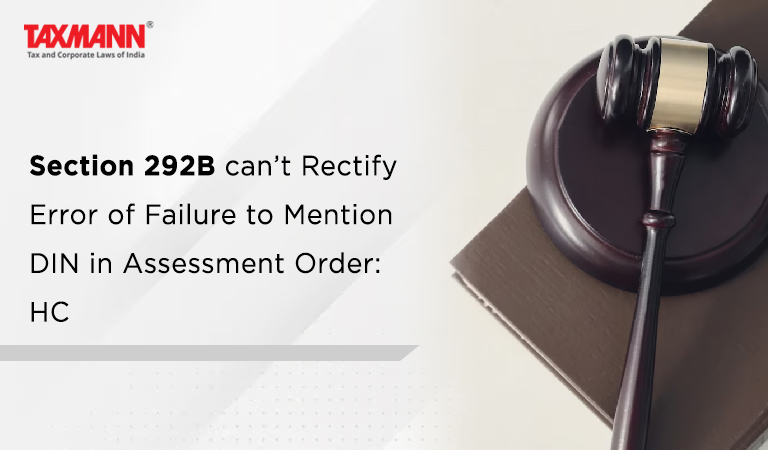Section 292B can’t Rectify Error of Failure to Mention DIN in Assessment Order: HC
- Blog|News|Income Tax|
- 2 Min Read
- By Taxmann
- |
- Last Updated on 16 April, 2023

Case Details: CIT (International Taxation) Vs. Brandix Mauritius Holdings Ltd. - [2023] 149 taxmann.com 238 (Delhi)
Judiciary and Counsel Details
-
- Rajiv Shakdher & Ms Tara Vitasta Ganju, Jj.
- Puneet Rai, Ashvini Kumar & Ms Madhavi Shukla for the Appellant.
- Ajay Vohra, Sr. Adv. & Guruprasad, Adv. for the Respondent.
Facts of the Case
The instant appeal was filed before the Delhi High Court by the revenue against the order of the Tribunal. The Tribunal relied on the CBDT’s Circular No. 19/2019 dated 14.08.2019 and set aside the final assessment order passed by the Assessing Office (AO) without mentioning Document Identification Number (DIN).
The AO believed that the failure to generate and allocate DIN is a mistake or, at best, a defect and/or an omission, which ought not to invalidate the assessment proceedings as per section 292B.
High Court Held
The Delhi High Court held that Circular No. 19/2019 sets out how DIN is required to be circulated while communicating a notice, order, summon, letter and any correspondence issued by the Income Tax Department. It mandates the allocation of DIN for every communication issued by any income tax authority to the assessee or any other person. It also provided for manual communication in exceptional circumstances that required approval from the appropriate authority within 7 days or 15 days, as the case may be.
The Court held that the object and purpose of the issuance of the circular was to create an audit trail. The circular clearly provided that any communication not in conformity with the provisions of the circular, be treated as invalid and deemed to have never been issued. The phraseology of the circular also includes communication of assessment order rendering it non-est in law. There was nothing on record to show that the AO took steps to demonstrate that there were exceptional circumstances which would sustain the communication of the final assessment order manually without DIN.
Further, such circulars issued by CBDT are binding on the department officials. The argument advanced on behalf of the AO that recourse can be taken to Section 292B is untenable, having regard to the phraseology used in the circular.
Thus, the Court held that not mentioning DIN in the communications cannot be considered a defect or mistake and upheld the Tribunal’s decision.
Disclaimer: The content/information published on the website is only for general information of the user and shall not be construed as legal advice. While the Taxmann has exercised reasonable efforts to ensure the veracity of information/content published, Taxmann shall be under no liability in any manner whatsoever for incorrect information, if any.

Taxmann Publications has a dedicated in-house Research & Editorial Team. This team consists of a team of Chartered Accountants, Company Secretaries, and Lawyers. This team works under the guidance and supervision of editor-in-chief Mr Rakesh Bhargava.
The Research and Editorial Team is responsible for developing reliable and accurate content for the readers. The team follows the six-sigma approach to achieve the benchmark of zero error in its publications and research platforms. The team ensures that the following publication guidelines are thoroughly followed while developing the content:
- The statutory material is obtained only from the authorized and reliable sources
- All the latest developments in the judicial and legislative fields are covered
- Prepare the analytical write-ups on current, controversial, and important issues to help the readers to understand the concept and its implications
- Every content published by Taxmann is complete, accurate and lucid
- All evidence-based statements are supported with proper reference to Section, Circular No., Notification No. or citations
- The golden rules of grammar, style and consistency are thoroughly followed
- Font and size that’s easy to read and remain consistent across all imprint and digital publications are applied




